Scottish Water treats 983ML* of wastewater per day.
Our biological treatment processes generate nitrous oxide (N2O) and methane (CH4). Both are greenhouse gases.
This is the equivalent of 43kt CO2e pa.
*1 ML (megalitre) = 1 million litres

2019/20 POSITION
PER DAY
WASTEWATER
TREATED
43kt CO2e
NITROUS OXIDE AND
METHANE PRODUCED
2019/20 POSITION
983ML
PER DAY
WASTEWATER
TREATED
43kt CO2e
PER ANNUM
NITROUS OXIDE AND METHANE PRODUCED
WASTEWATER
AERATION
WASTEWATER
SLUDGE TREATMENT
WASTEWATER
SLUDGE STORAGE
WASTEWATER
AERATION
WASTEWATER
SLUDGE TREATMENT
WASTEWATER
SLUDGE STORAGE
OUR APPROACH

REDUCE
EMISSION PRODUCTION
MAXIMISE ENERGY
RECOVERED FROM BIORESOURCE
These tables illustrate the key activities we are
exploring to reduce our process emissions.
We will keep these under review
with our expert advisory panel.

UP TO
2025
• Identify and implement more accurate measurement and accounting for process emissions.
UP TO
2030
UP TO
2040
• Demonstrate optimisation of WWTWs and Sludge Treatment Centres to decrease production of N2O.
• Implement optimisation of WWTWs and Sludge Treatment Centres to decrease production of N2O.
• Complete optimisation of WWTWs and Sludge Treatment Centres to decrease production of N2O.
• Identify, assess and demonstrate sludge storage and transport optimisation to decrease methane emissions.
• Implement sludge storage and transport optimisation to decrease methane emissions.
• Complete sludge storage and transport optimisation to decrease methane emissions.
• Technology scouting for innovative technology to reduce process emissions.

UP TO
2025
• Identify and implement more accurate measurement and accounting for process emissions.
• Demonstrate optimisation of WWTWs and Sludge Treatment Centres to decrease production of N2O.
• Identify, assess and demonstrate sludge storage and transport optimisation to decrease methane emissions.
• Technology scouting for innovative technology to reduce process emissions.
UP TO
2030
• Implement optimisation of WWTWs and Sludge Treatment Centres to decrease production of N2O.
• Implement sludge storage and transport optimisation to decrease methane emissions.
UP TO
2040
• Complete optimisation of WWTWs and Sludge Treatment Centres to decrease production of N2O.
• Complete sludge storage and transport optimisation to decrease methane emissions.
DEVELOP RECOVERY OF
AMMONIA FROM WASTEWATER
AVOIDING PROCESS EMISSIONS
DEVELOP METHANE
CAPTURE TECHNOLOGY,
AVOIDING PROCESS EMISSIONS
IDENTIFY CIRCULAR ECONOMY
OPPORTUNITIES FOR USE OF
RECOVERED AMMONIA
INNOVATION CHALLENGES
DEVELOP RECOVERY OF
AMMONIA FROM WASTEWATER
DEVELOP METHANE
CAPTURE TECHNOLOGY,
AVOIDING PROCESS EMISSIONS
IDENTIFY CIRCULAR ECONOMY
OPPERTUNITIES FOR USE OF
RECOVERED AMMONIA
INNOVATION CHALLENGES
DEVELOP RECOVERY OF
AMMONIA FROM WASTEWATER
DEVELOP METHANE
CAPTURE TECHNOLOGY,
AVOIDING PROCESS EMISSIONS
IDENTIFY CIRCULAR ECONOMY OPPORTUNITIES FOR USE OF RECOVERED AMMONIA
KEY ENABLERS TO SUPPORT
REDUCING PROCESS EMISSIONS
PEOPLE CAPABILITY
Expand our process
science skills
TECHNOLOGY
Developing improved process
monitoring equipment
MARKETS
Develop a quality product
for the circular economy
KEY ENABLERS TO
SUPPORT REDUCING PROCESS EMISSIONS
PEOPLE CAPABILITY
Expand our process
science skills
TECHNOLOGY
Developing improved process
monitoring equipment
MARKETS
Develop a quality product
for the circular economy
EXTERNAL FACTORS THAT SUPPORT
REDUCING PROCESS EMISSIONS
INCENTIVES
to stimulate technology
development for
energy recovery
INTERNATIONAL REVIEWS OF GREENHOUSE GAS
EMISSIONS FACTORS
for methane and
nitrous oxide
REGULATORY FRAMEWORK
EXTERNAL FACTORS THAT SUPPORT REDUCING PROCESS EMISSIONS
INCENTIVES
to stimulate technology
development for
energy recovery
INTERNATIONAL REVIEWS OF GREENHOUSE GAS
EMISSIONS FACTORS
for methane and
nitrous oxide
REGULATORY FRAMEWORK
INTRODUCTION

TRANSFORMATION



ELECTRICITY

PROCESS
EMISSIONS

GAS &
FUEL OIL

TRANSPORT
& TRAVEL

INVESTMENT

STORING
CARBON
Scottish Water has established a framework for the supply of sustainably sourced hydrotreated vegetable oil that can be used by both Scottish Water and its construction partners. It’s a drop in fuel replacement that reduces emissions by 90% compared to conventional diesel.
Over the last year it has been widely adopted by our construction partners, displacing diesel use in excavators, cranes and other heavy plant. It is also being used to fuel generators to provide power for remote construction sites.
On our water mains rehabilitation programme its adoption is expected to reduce emissions by nearly 30%.